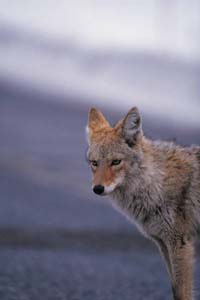 Getting permission from hundreds of private landowners for scat studies or trapping can make surveying coyote populations in the East tough. Sara Hansen, a grad student at the SUNY College of Environmental Science and Forestry, tested a method using coyote vocalizations, and found it was effective.
Getting permission from hundreds of private landowners for scat studies or trapping can make surveying coyote populations in the East tough. Sara Hansen, a grad student at the SUNY College of Environmental Science and Forestry, tested a method using coyote vocalizations, and found it was effective.
Her method was to play a recording of a coyote vocalization while observers listened from three points along a road. When a coyote responded, the observers took a compass bearing for the spot. The project had 541 survey points and got 117 responses.
To play the vocalization, two megaphones, two mini-amps and an mp3 player with a 20 second recording of coyote vocalization from the Cornell Laboratory of Ornithology collection were used. Hansen says the set up cost about $60.
Hansen was able to test the method’s effectiveness because another project at the school had radio-collared coyotes. Estimating total population from the responses requires an algorithm, but Hansen found that triangulating the compass bearings from the observers who heard the howl worked very well.
She found that wind speeds were important, and that the method was not effective when wind speeds were over 5 km/hour. Running water was also a problem, and hemlocks, she said, “were kryptonite.”
Hansen gave her presentation at the Northeast Fish and Wildlife Conference yesterday. Unfortunately, there doesn’t seem to be a published paper for more details, but this five-page grant report does have some details. Also, this progress report has some info. (It is a PDF and the information on this project starts at the bottom of page 9.)
By the way, she estimates New York’s coyote population to be 30,000 to 35,000.
